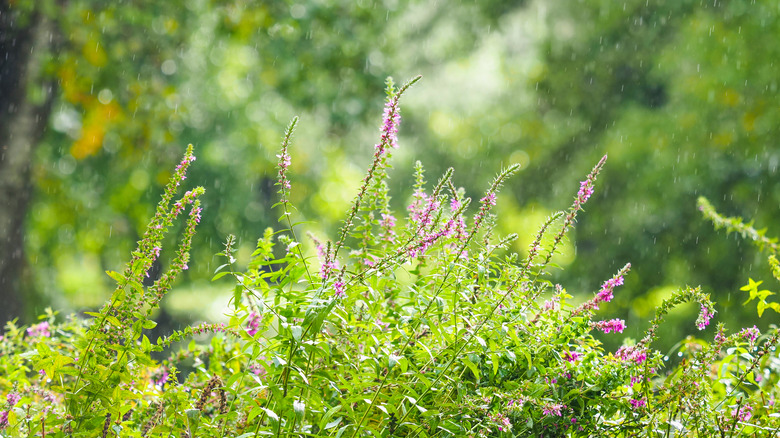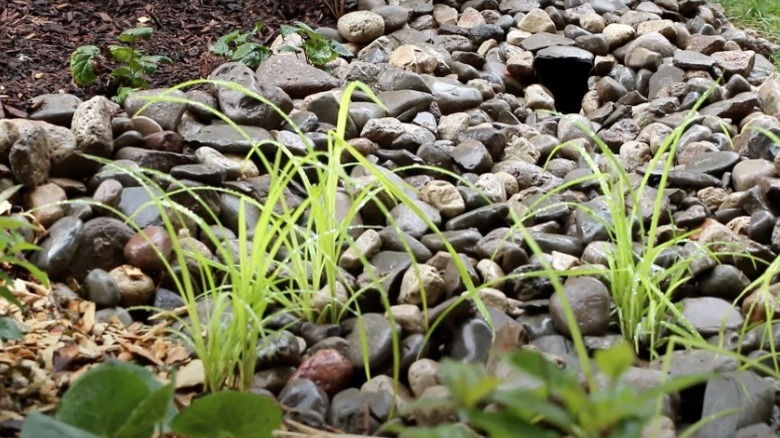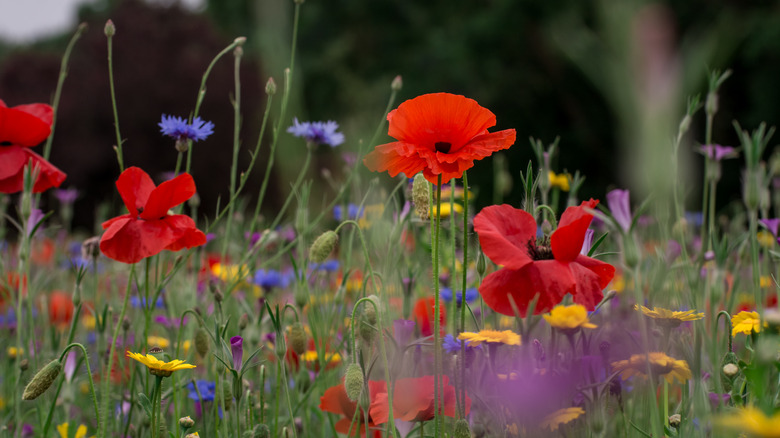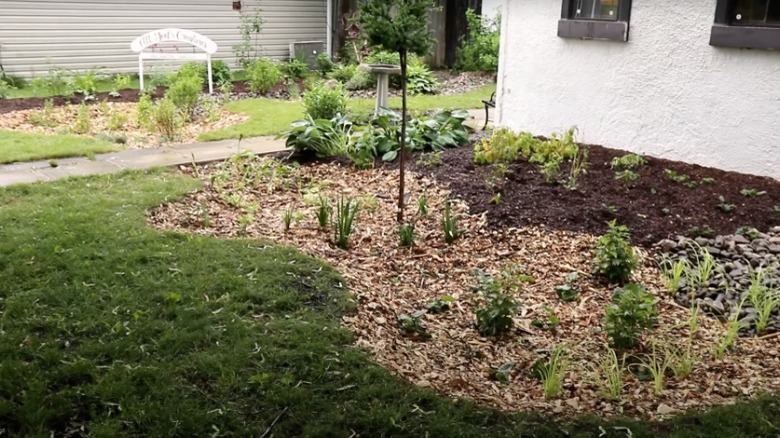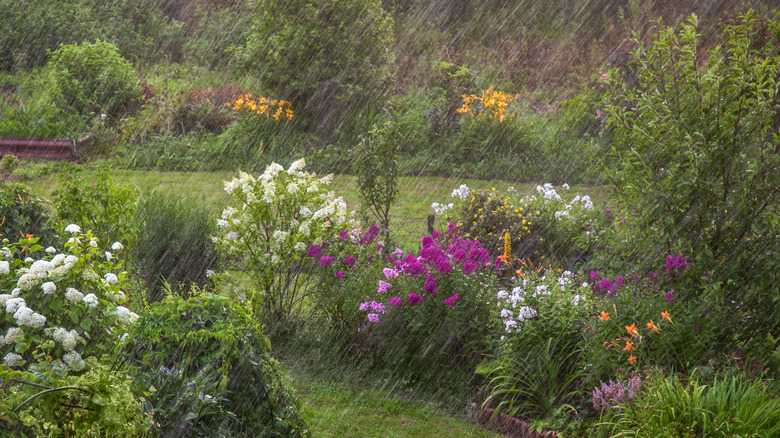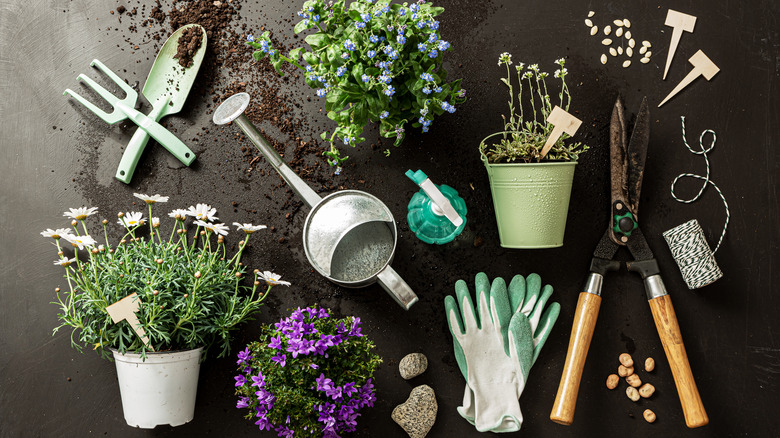What Is A Rain Garden?
Depending on where you live and the average rainfall for your area, you might have to occasionally deal with flooding on your property. Per the U.S. Environmental Protection Agency (EPA), the runoff that inevitably comes from heavy rainfall isn't only responsible for this flooding; it can also pollute waterways by carrying with it bacteria, refuse, chemical residues, and harmful heavy metals. This pollution negatively affects the flora and fauna that depend on that water for life, and it can disrupt the natural balance of the ecosystem. Also consider that when left to accumulate in your yard or driveway, high levels of stormwater runoff can cause damage to the structures on your property.
Rain gardens are one element of green infrastructure that have proven to help with this problem. As opposed to gray infrastructure like gutters and underground pipes that move runoff to an offsite location, green infrastructure relies on nature to develop systems that can quickly filter and reabsorb the excess water back into the ground as it continues to fall. Protection from heavy rainfall that would otherwise flood your property is one of the benefits you can attain from planting a rain garden. Filtration and removal of chemical residues is another.
Rain gardens are different than regular gardens
When planting a standard landscape or backyard garden, the focus lies on what types of plants you wish to eventually harvest and/or use to beautify your property. Rain gardens serve a completely different and specific function. They're not there to provide edible vegetables for your next meal, nor are they meant to be the most decorative area of your yard, although they certainly can be. Instead, rain gardens are planted into depressed areas in order to do the job of preventing floods and runoff. They do this by collecting excessive water from heavy rainfall into what is basically a sunken basin and reabsorbing it into the ground. Rain gardens are also different from swales, which are used to slow the rush of runoff and divert it to a designated area, explains Pittsburgh Water & Sewer Authority.
As a rain garden collects runoff, the plants it contains act as a unified filtration system. Landscaping expert Sean James explains that bioremediation is one of the things plants do best (via Buying Thyme's YouTube channel); this is the process of filtering harmful chemicals out of polluted water. That means a well-installed rain garden can go a long way in terms of preserving the health of the environment.
The best plants for a rain garden
Because your rain garden is ultimately there to do a job, you'll want to choose the most appropriate and hard-working plants. For this, native species are usually the best choices. University of Florida IFAS Extension (UF/IFAS) reminds us that native plants need the least amount of attention because they're suited to grow naturally in a given area. It seems like an obvious point, yet how often do we really consider them over the decorative options we really want? Native species require less fertilizer, which is doubly important given the fact that one of the purposes of the rain garden is to filter and absorb potentially harmful residue from chemicals like overused fertilizers. Of course, the plants also attract birds and other beneficial pollinators that will do much of the work to keep your garden thriving.
Tall grasses work as excellent filtration systems, and large shrubs and trees are good at catching droplets of rain amongst branches and leaves, slowing down the gush so that it can be more fully absorbed over a longer period of time, notes the Old Farmer's Almanac. Plants with deep roots are equally efficient at stopping water from becoming runoff by shuttling it farther down into the ground. Water mitigation experts at All Dry USA include canna lilies, iris, elephant ears, and cattails on their list of effective deep-rooted plants.
The best location for a rain garden
The ideal placement for your rain garden is underneath a downspout that flushes out water from the roof as it is sent down through the gutter system. The EPA notes the importance of contacting local officials before you construct a rain garden; they'll know where it's safe to dig and if there are any areas you need to avoid due to buried power lines, plumbing tunnels, septic tanks, etc. Account for tree roots as well when planning your design (via UF/IFAS). Remember too that rain gardens are defined as depressions, or low spots, so if you already have a naturally depressed area of which you can make use, you might as well place your garden there rather than excavating another spot.
Just like any other type of garden, a rain garden will require ample exposure to direct sunlight. Most houses have more than one downspout as part of the overall gutter system, so opt to install your garden on the side of the house that receives the most light. If that side runs along your neighbor's property line, you might consider bringing them into the plan so that you can both benefit from a single rain garden.
What size rain garden should you plant?
Time and money will inevitably dictate the scope of all your home improvement projects, yet there are considerations specific to the function of a rain garden that must be included here. For instance, the size of your roof and the type of soil in your yard will impact the size of your rain garden. In regard to soil, different types will need to be set at different depths, so when you plan for overall size it won't only be about surface area. Sean James recommends depths of 4 to 6 inches for clay, 12 inches for loam, and up to 24 inches for sandy soil.
Next up, you'll need to survey your house for downspouts to get a good sense of how much of the roof's runoff is likely to flow to your garden. If you count three downspouts, you'll know that the one next to your designated location will capture roughly a third of the runoff. The square footage of your roof is another number you'll need to calculate. UF/IFAS offers charts that show you how to use those numbers to determine the appropriate size of your rain garden.
How to design and build a rain garden
Per Sean James, the runoff water needs to be moved a minimum of 6 feet away from any structural foundations before it can be absorbed into the ground. This can be accomplished by installing a pond liner underneath an extension of river rocks. James likes to think of it as sculpting as opposed to digging when he gets to the point of tilling the soil. Instead of a shovel, he uses a pick and gently whittles away at the topsoil to create the path of the river rock and, therefore, the runway of rocks that will guide the roof runoff away from the foundation.
If your property slopes down, you can still build a rain garden but you'll have to structure it so it steps down gradually using berms to create individual rain garden pools. James explains that the water needs to collect and then soak into the ground. It will be helpful to remember that the intention of a rain garden is not to flush water away; the water is ultimately meant to seep down into the ground.
